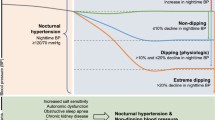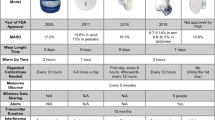Abstract
Purpose
To develop and validate a continuous non-invasive blood pressure (BP) monitoring system using photoplethysmography (PPG) technology through pulse oximetry (PO).
Methods
This prospective study was conducted at a critical care department and post-anesthesia care unit of a university teaching hospital. Inclusion criteria were critically ill adult patients undergoing invasive BP measurement with an arterial catheter and PO monitoring. Exclusion criteria were arrhythmia, imminent death condition, and disturbances in the arterial or the PPG curve morphology. Arterial BP and finger PO waves were recorded simultaneously for 30 min. Systolic arterial pressure (SAP), mean arterial pressure (MAP), and diastolic arterial pressure (DAP) were extracted from computer-assisted arterial pulse wave analysis. Inherent traits of both waves were used to construct a regression model with a Deep Belief Network-Restricted Boltzmann Machine (DBN-RBM) from a training cohort of patients and in order to infer BP values from the PO wave. Bland–Altman analysis was performed.
Results
A total of 707 patients were enrolled, of whom 135 were excluded. Of the 572 studied, 525 were assigned to the training cohort (TC) and 47 to the validation cohort (VC). After data processing, 53,708 frames were obtained from the TC and 7,715 frames from the VC. The mean prediction biases were −2.98 ± 19.35, −3.38 ± 10.35, and −3.65 ± 8.69 mmHg for SAP, MAP, and DAP respectively.
Conclusions
BP can be inferred from PPG using DBN-RBM modeling techniques. The results obtained with this technology are promising, but its intrinsic variability and its wide limits of agreement do not allow clinical application at this time.

Similar content being viewed by others
Abbreviations
- AAMI:
-
Association for the Advancement of Medical Instrumentation
- ANOVA:
-
Analysis of variance
- APACHE II:
-
Acute Physiology and Chronic Health Evaluation II
- BP:
-
Blood pressure
- DAP:
-
Diastolic arterial pressure
- DBN-RBM:
-
Deep Belief Network-Restricted Boltzmann Machines
- GE:
-
General Electric
- MAP:
-
Mean arterial pressure
- PO:
-
Pulse oximetry
- PPG:
-
Photoplethysmography
- SAP:
-
Systolic arterial pressure
- SOFA:
-
Sequential Organ Failure Assessment
- TC:
-
Training cohort
- VC:
-
Validation cohort
References
Warren DK, Quadir WW, Hollenbeak CS et al (2006) Attributable cost of catheter-associated bloodstream infections among intensive care patients in a nonteaching hospital. Crit Care Med 34:2084–2089
Scheer BV, Perel A, Pfeiffer UJ (2002) Clinical review: complications and risk factors of peripheral arterial catheters used for haemodynamic monitoring in anaesthesia and intensive care medicine. Crit Care 6:198–204
Lorente L, Galvan R, Martín MM et al (2003) Trate of intravascular catheter infection line days. Med Intensiva 27:224–228
Stolt M, Sjönell G, Aström H et al (1993) Improved accuracy of indirect blood pressure measurement in patients with obese arms. Am J Hypertens 6:66–71
Bur A, Hirschl MM, Herkner H et al (2000) Accuracy of oscillometric blood pressure measurement according to the relation between cuff size and upper-arm circumference in critically ill patients. Crit Care Med 28:371–376
Jones DW, Apple LJ, Sheps SG et al (2003) Measuring blood pressure accurately. New and persistent changes. JAMA 289:1027–1030
Allen J (2007) Photoplethysmography and its applications in clinical physiological measurement. Physiol Meas 28:R1–R39
Anderson RR, Parrish JA (1981) The optics of human skin. J Invest Dermatol 77:13–19
Laurent C, Jönsson B, Vergfors M et al (2005) Non-invasive measurement of systolic blood pressure on the arm utilising photoplethysmography: development of methodology. Med Biol Eng Comput 43:131–135
Nitzan M, Faib I, Friedman H (2006) Respiration-induced changes in tissues blood volume distal to occluded artery, measured by photoplethysmography. J Biomed Opt 11:040506
Nitzan M, Patron A, Glik Z et al (2009) Automatic non-invasive measurement of systolic blood pressure using photoplethysmography. Biomed Eng Online 8:28
Association for the Advancement of Medical Instrumentation. American National Standard (2002) Manual, Electronic or Automated Sphygmomanometers. ANSI/AAMI SP10. ANSI, Arlington, VA
Bland JM, Altman DG (2007) Agreement between methods of measurement with multiple observations per individual. J Biopharm Stat 17:571–582
Bland JM, Altman DG (1999) Measuring agreement in method comparison studies. Stat Methods Med Res 8:135–160
Van Egmond J, Hasenbos M, Crul JF (1985) Invasive versus non-invasive measurement of arterial pressure. Comparison of two automatic methods and simultaneously measured direct intra-arterial pressure. Br J Anaesth 57:434–444
Peñaz J (1973) Photoelectric measurement of blood pressure, volume and flow in the finger. In: Albert A, Vogt W, Hellig W (eds) Digest of the 10th International Conference on Medical and Biological Engineering. International Federation for Medical and Biological Engineering, Dresden, Germany, p 104
Janelle GM, Gravenstein N (2006) An accuracy evaluation of the T-Line® Tensymeter (continuous non-invasive blood pressure management device) versus conventional invasive radial artery monitoring in surgical patients. Anesth Analg 102:484–490
Belani KG, Buckley JJ, Poliac MO (1999) Accuracy of radial artery blood pressure determination with the Vasotrac. Can J Anaesth 46:488–496
McCann ME, Hill D, Thomas KC et al (2005) A comparison of radial artery blood pressure determination between the Vasotrac device and invasive arterial blood pressure monitoring in adolescents undergoing scoliosis surgery. Anesth Analg 101:978–985
Belani K, Ozaki M, Hynson J et al (1999) A new non-invasive method to measure blood pressure. Anesthesiology 91:686–692
Szmuk P, Pivalizza E, Warters RD et al (2008) An evaluation of the T-Line© Tensymeter continuous non-invasive blood pressure device during induced hypotension. Anaesthesia 63:307–312
Findlay JY, Gali B, Keegan MT et al (2006) Vasotrac® arterial blood pressure and direct arterial blood pressure monitoring during liver transplantation. Anesth Analg 102:690–693
Saugel B, Fassio A, Hapfelmeier A et al (2012) The T-Line TL-200 system for continuous non-invasive blood pressure measurement in medical intensive care unit patients. Intensive Care Med 38:1471–1477
Suzuki S, Oguri K (2008) Cuffless and non-invasive systolic blood pressure estimation for aged class by using a photoplethysmograph. Conf Proc IEEE Eng Med Biol Soc 2008:1327–1330
Suzuki S, Oguri K (2009) Cuffless blood pressure estimation by error-correcting output coding method based on an aggregation of adaboost with a photoplethysmograph sensor. Conf Proc IEEE Eng Med Biol Soc 2009:6765–6768
Monte-Moreno E (2011) Non-invasive estimate of blood glucose and blood pressure from a photoplethysmograph by means of machine learning techniques. Artif Intell Med 53:127–138
Hinton GE, Onsidero S, Teh YW (2006) A fast learning algorithm for deep belief nets. Neural Comput 18:1527–1554
Hinton GE, Salkhutdinov RR (2006) Reducing the dimensionality of data with neural networks. Science 313:504–507
Dueck R, Goedje O, Clopton P (2012) Nonivasive continuous beat-to-beat radial pressure artery via TL-200 applanation tonometry. J Clin Monit Comput 26:75–839
Lehman LH, Saeed M, Talmor D et al (2013) Methods of blood pressure measurement in the ICU. Crit Care Med 41:34–40
Panerai RB, Sammons EL, Smith SM et al (2007) Transient drift between finapres and continuous intra-aortic measurement of blood pressure. Blood Pres Monit 12:369–376
Acknowledgments
This work was supported in part by Sabirmedical SL (Parc Cientific de Barcelona, Barcelona, Spain), and by “Avanza” grants (Ministry of Industry, Tourism and Trade, Government of Spain, TSI-020100-2009-204 and TSI-020100-2010-625).
Conflicts of interest
J.C. Ruiz-Rodriguez and J. Caballero have received grant support for travel expenses from Sabirmedical SL. J.C. Ruiz-Rodriguez, J. Caballero, A. Ruiz-Sanmartin, J. Riera, S. García-Roche, and J. Rello have collaborated with Sabirmedical SL in other research projects or in an advisory capacity. V. Ribas was the scientific director of Sabirmedical. O. de Sola-Morales was Sabirmedical’s medical and market access director. No other authors report any financial disclosures.
Author information
Authors and Affiliations
Corresponding author
Electronic supplementary material
Below is the link to the electronic supplementary material.
Rights and permissions
About this article
Cite this article
Ruiz-Rodríguez, J.C., Ruiz-Sanmartín, A., Ribas, V. et al. Innovative continuous non-invasive cuffless blood pressure monitoring based on photoplethysmography technology. Intensive Care Med 39, 1618–1625 (2013). https://doi.org/10.1007/s00134-013-2964-2
Received:
Accepted:
Published:
Issue Date:
DOI: https://doi.org/10.1007/s00134-013-2964-2




